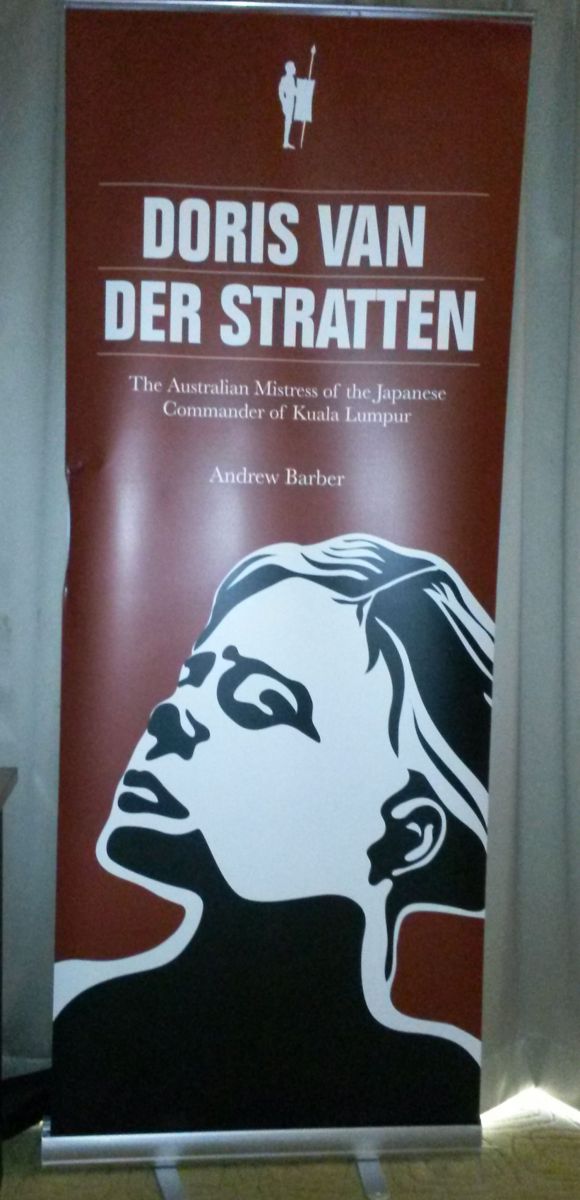
In today’s modern metropolis, it’s hard to imagine that the Lee Rubber Building, situated on the corner of Jalan Tun H S Lee in the heart of Chinatown, was once the tallest building in Kuala Lumpur. Built in the 1930s by Lee Kong Chian, this historic Art Deco four-storey structure, designed by British Architect Arthur Oakley Coltman, is now a listed building preserving Malaysia’s fascinating heritage, and so too, the landmark’s sinister past.
During World War II, under the Japanese occupation, the Lee Rubber Building served as the headquarters for the dreaded Kempetei (Japanese secret service). In August 1943 Australian housewife Doris van der Stratten, mistress of Japanese military officer Colonel Koda, plunged to her death from the upper floor window following three days of intense interrogation. The question that lay on everyone’s lips was whether she jumped or was she pushed?
Amateur historian and author Andrew Barber first touched upon Doris' story in his earlier book Kuala Lumpur at War 1939 – 1945 written in 2010, which explores the consequences of WWII on the city and its people. Feeling dissatisfied with a five-page entry at the end of a chapter about Comfort Women and intrigued by the events leading to Doris’ death, Andrew painstakingly researched her life story, the material of which translates into a compelling narrative. Introducing his new book entitled Doris van der Stratten, Andrew gave us an insight into the life of an extraordinary woman, living in extraordinary times.
Born in London in 1904, Doris spent most of her life in Adelaide, Australia. Her mother, Pauline Health, led a wayward lifestyle: a much publicized court case involving her abusive lover’s behaviour was cited when Doris’ father Neil Henry, whom Pauline married in 2010, filed for divorce on grounds of her adultery. Doris, it appears, followed in her mother’s footsteps in that she too enjoyed the many bars and clubs in Adelaide. Her nine-year marriage to billiard saloon proprietor Richard Wall ended in divorce in 1934, their two daughters Rosemary and Winifred, living with their father; a custody decision that does not appear to have been contested. Sadly, Doris would become estranged not only from her mother, but also her two daughters.
In the mid 1930s Doris met Eurasian mining engineer Phillip van der Stratten, a softly spoken gentleman with a love of music; a personality that would seem in direct contrast to Doris’ feisty nature. Nevertheless, the unlikely couple was soon to marry, with Doris abandoning her volatile lifestyle to live with the respectable van der Stratten family in colonial Malaya. Later, the couple moved to southern Thailand where Philip worked as an electrical engineer for a tin mining company in Pinyok. It is thought that Doris would have enjoyed socializing in a society that was probably less judgmental than the straight-laced expatriate community in Kuala Lumpur. However, the good times were not to last.

On December 8th, 1941 the Japanese landed on the beachheads in Thailand: all British, Eurasian and Europeans in the vicinity were rounded up, bundled into a truck and driven to a mining site in Kampong Toh, where they were forced into a wooden bungalow. Initially they were treated amicably, but on the following day it was announced that the detainees were spies and within moments 15 soldiers surrounded the bungalow. The soldiers opened fire and threw hand grenades into the building, returning the next day with bayonets to finish off anyone showing signs of life.
Mercifully, Doris was among those who survived the massacre, and mistakenly believing her husband to be dead, fled into the jungle with companion, Edward Peters. Thereafter followed a treacherous journey as the couple headed towards Malaya on foot, expecting to find safety. The dense jungle was largely impermeable, and while Edward was trained in Intelligence, poor Doris was just a housewife; we can only try to imagine the suffering she endured while facing the perils of the jungle, her slight body progressively withering through malnutrition and disease.
Eventually they made their way to Perak, finding refuge among a small Chinese community who were hiding in the depths of the jungle. This was not without risk because there was rumour that the Japanese were offering financial reward to informers. Exhausted after an arduous five-month ordeal and fearing for their life, Edward and Doris turned themselves in. The Japanese immediately took them to Taiping prison where Doris was given medical assistance and offered treatment in a hospital run by nuns, though she courageously chose to remain with her fellow Europeans despite being the only woman among 350 POW civilian interns. While incarcerated she penned a series of poems and instructed the La Salle brothers, whom she had befriended, to send them to her daughters in Australia.
In May 1942, the POWs were taken to Pudu Prison in Kuala Lumpur. Doris, who was still receiving medical treatment, remained isolated, but her ‘luck’ was about to change. Colonel Koda, who was responsible for operations in Taiping, was transferred to Kuala Lumpur where he was to become Commander of Pudu prison. Taking ‘pity’ on vulnerable Doris, he took her to an elegant property in Penang Road near the race course where she was to become his ‘Italian’ mistress—an arrangement that was met with much disdain, not least from the van der Stratten family, most of who perished in the war.

A year or so later Colonel Koda, who had been stealing supplies, found himself under investigation on a charge of corruption. This led to Doris being taken to the Kempetei headquarters where it soon became apparent that she was not Italian. And so began a brutal interrogation by Lt Shuzi Murakami that ultimately led to her untimely death.
At the end of the war in 1945, the British set up a War Crimes Court and, without too much difficulty, managed to track down Murakami. However, despite evidence from an eye-witness stating that Doris had been pushed out of the window, Murakami was cleared of all charges; a verdict that would seem to be the final indignity to Doris’ troubled and sorrowful life. We will never really know what happed on that fateful day in 1943 in the interrogation room on the top floor of the Lee Rubber Building, but it is fair to say that Murakami was ‘morally culpable’ even if he was not ‘legally’ guilty of Doris’ death.
When researching for the book, Andrew tells us that he was lucky enough to get to know Paget Natten and her mother, who was Doris’ sister-in-law. While opinions within the van der Stratten family were conflicting, Paget was sympathetic and viewed her aunty Doris as a victim of circumstance. And we know too, her husband Philip forgave her; tragically he had spent the entire war believing that Doris had died in the Kampong Toh massacre.
Andrew also discovered the La Salle brothers had honored their pledge and Doris’ poems were delivered to her daughters in 1973. Despite much effort, he was unable to trace them, but it is a comfort to know that Doris’ heartfelt words had reached their intended recipient and perhaps some ‘ghosts’ were finally laid to rest.
Doris van der Stratten is published by Karamoja Press, Malaysia and is available through MPH bookstores priced at RM80. All profits from the sale of the book will be donated to the Lighthouse Children’s Home, a local orphanage.
Written by Chrissie Kemp
